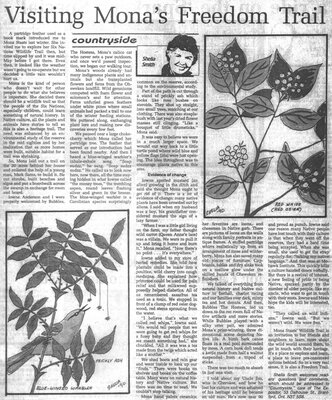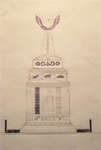"Visiting Mona's Freedom Trail"
- Publication
- Brantford Expositor, 2 Jun 1990
- Full Text
- Visiting Mona's Freedom Trail
A partridge feather used as a book mark introduced me to Mona Staats last winter. She invited me to explore her Six Nations Wildlife Trail then, but time slipped by and it was mid-May before I got there. Even then, it looked like the weather wasn't going to co-operate but we decided a little rain wouldn't hurt us.
Mona is the kind of person who doesn't wait for other people to do what she believes is important. She decided there should be a wildlife trail so that the people of the Six Nations especially children, could learn something of natural history. In Native culture, all the plants and animals have stories to tell so this is also a heritage trail. The need was enhanced by an environmental study of the reserve in the mid eighties and by her realization that as more homes were built, suitable habitat for a trail was shrinking.
So, Mona laid out a trail on the 20 acres behind her house and enlisted the help of a young man, Mark Sams, to build it. He cut shrubs, built benches and signs and put a boardwalk across the swamp in exchange for room and board.
Iowne Anderson and I were properly welcomed by Bubbles, The Hostess, Mona's calico cat who never sets a paw outdoors, and once we'd passed inspection, we began our walking tour.
Mona's woods already had many indigenous plants and animals but she transplanted flowers and ferns from the Ohsweken landfill. Wild geraniums competed with foam flower and solomon's seal for attention. Ferns unfurled green feathers under white pines where small animals had packed a trail to one of the winter feeding stations. We puttered along, exchanging plant lore and making new discoveries every few feet.
We paused near a large chokecherry which Mona called her partridge tree. The feather that served as our introduction had been found nearby. And then I heard a blue-winged warbler's inhale-exhale song. "Soap sudzz," he sang. "Soap sudzz sudzz." He called us to look now here, now there, all the time staying hidden in what Iowne called "the money trees," the trembling aspen, round leaves flashing silver and green in the breeze. The blue-winged warbler is a Carolinian species surprisingly common on the reserve, according to the environmental study.
Part of the path is cut through a stand of prickly ash which looks like rose bushes on steroids. They shot up straight, into small trees, snatching at our clothing. There was also steeple-bush with last year's dried flower masses still clinging. "Like a bouquet of little drumsticks," Mona said.
It was easy to believe we were in a much larger space. We wound our way back to a little turtle pond where wild blue and yellow flags (iris) were just opening. The idea throughout was to encourage plants native to this area.
Evidence of changeIowne spotted mustard (an alien) growing in the ditch and said she thought Mona ought to get rid of it. There is a lot of evidence of change; many native plants have been crowded out by aliens. I said when my husband was a boy, his grandfather considered mustard the sign of a lazy farmer.
"When I was a little girl living on the farm, my father though wild carrot (Queen Anne's lace) was a villain. We were to pull it up and bring it home and burn it," Mona recalled. "Now there's no point... it's everywhere."
Iowne added to my store of herbal remedies. She told how plantain could be made into a poultice, wild cherry into cough medicine. She explained how primrose could be used for pain relief and that milkweed supposedly helped diabetics. All of us remembered sassafras tea used as a tonic. We stopped in front of a clump of red osier dogwood, red stems sprouting from the water.
"I believe that's what we called red whips," Iowne said. "We would tell people that we were going to get red whips for a fussy baby and they thought we meant something bad," she chuckled. "All it was was a tea made from the twigs which acted like a soother."
We shed boots and rain gear and went inside to look up our "finds." There were books on shelves and books on the coffee table. Many were on natural history and Native culture. But there was no time to read. We couldn't stop talking.
Mona hand paints ceramics; her favorites are loons, and chessmen in Native garb. There are pictures of loons on the walls along with family portraits in antique frames. A stuffed partridge whirrs realistically up from an arrangement of moss and winterberry. Mona has also saved many old pieces of furniture. Cupboards, tables and dry sinks took on a mellow glow under the skilled hands of Ohsweken refinishers.
We talked of everything from natural history and Native culture to fastball, chariot racing and our families over dark, minty tea and hot donuts. And then, Bubbles The Hostess, led us down to the rec room full of Native artifacts and more stories. While Bubble splayed with a silky otter pelt, we admired Mona's prize-winning, three dimensional scene depicting Native life. A birch bark canoe floats in a real pool surrounded by moss. A corn husk doll tends a kettle made from half a walnut suspended from a tripod of sticks.
There was too much to absorb in just one visit.
I told about my Uncle Jim, who is Cherokee, and how he lost his culture and was ashamed of his heritage until he became an old man. He's now near 90 and proud as punch. Iowne said one reason many Native people have lost touch with their culture is that when they went off the reserves, they had a hard time being accepted. When she was small, she used to get the strap regularly for, "talking my native language." And that was at Mohawk Institute. This quickly kills a culture handed down verbally. But there is a revival of interest, a new feeling of pride in being Native, sparked partly by the number of older people, like my uncle, who want to get in touch with their roots. Iowne and Mona hope the kids will be interested, too.
"They called us wild Indians," Iowne said. "But we weren't wild. We were free."
Mona Staats' Wildlife Trail is an invitation to her friends and neighbors to learn more about the wild world around them, to get in touch with their heritage. It's a place to explore and learn, a place to leave pre-conceived notions behind. So in a very real sense, it is also a Freedom Trail.
Sheila Smith welcomes readers' questions and comments, which should be addressed to "Countryside," care of The Expositor, 53 Dalhousie St., Brantford, Ont. N3T 5S8.
- Creator
- Smith, Sheila, Author
- Media Type
- Newspaper
- Publication
- Item Types
- Articles
- Clippings
- Description
- "A partridge feather used as a book mark introduced me to Mona Staats last winter. She invited me to explore her Six Nations Wildlife Trail then, but time slipped by and it was mid-May before I got there. Even then, it looked like the weather wasn't going to co-operate but we decided a little rain wouldn't hurt us."
- Date of Publication
- 2 Jun 1990
- Subject(s)
- Personal Name(s)
- Staats, Mona ; Anderson, Iowne ; Smith, Shelia ; Sams, Mark.
- Corporate Name(s)
- Six Nations Wildlife Trail ; Mohawk Institute.
- Local identifier
- SNPL003431v00d
- Collection
- Mona Staats
- Language of Item
- English
- Geographic Coverage
-
-
Ontario, Canada
Latitude: 43.06681 Longitude: -80.11635
-
- Donor
- Mona Staats
- Creative Commons licence
 [more details]
[more details]- Copyright Statement
- Public domain: Copyright has expired according to Canadian law. No restrictions on use.
- Copyright Date
- 1990
- Copyright Holder
- Brantford Expositor
- Location of Original
- Mona Staats
- Contact
- Six Nations Public LibraryEmail:info@snpl.ca
Website:
Agency street/mail address:1679 Chiefswood Rd
PO Box 149
Ohsweken, ON N0A 1M0
519-445-2954



